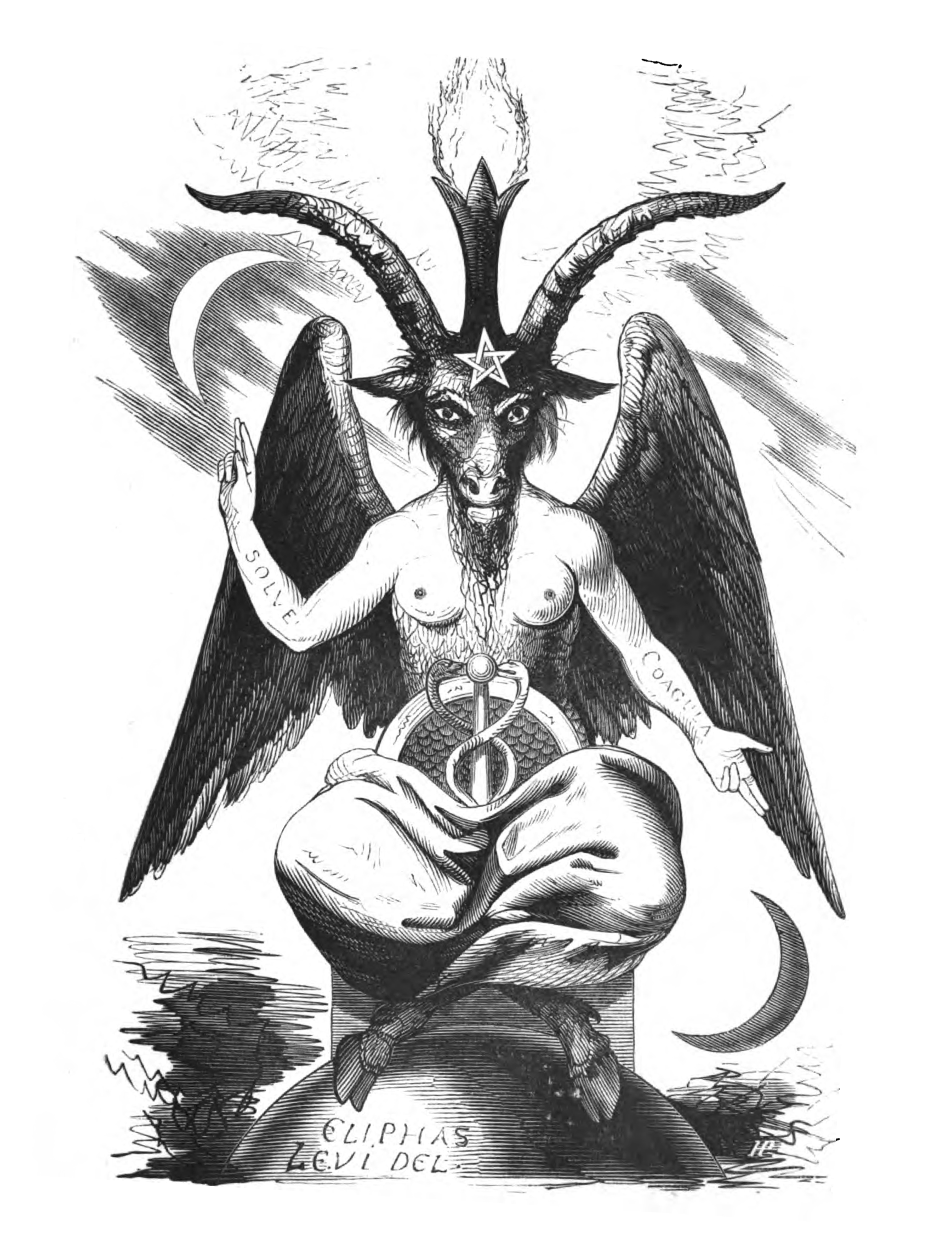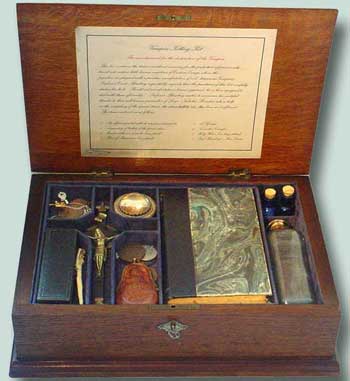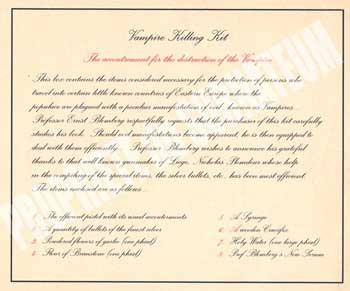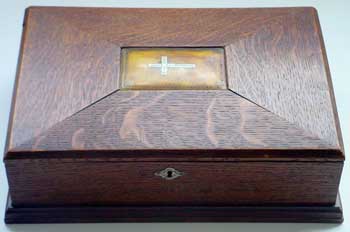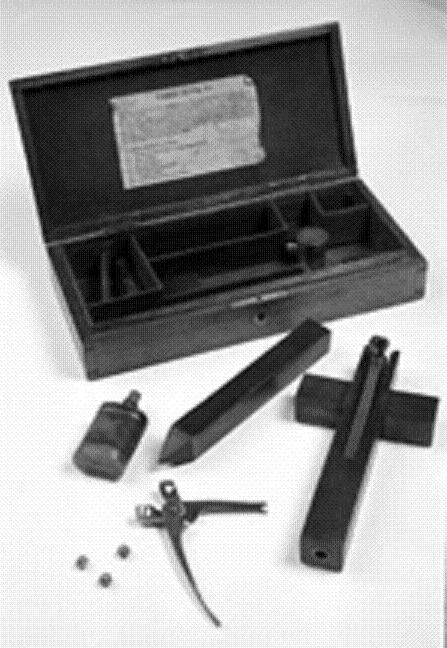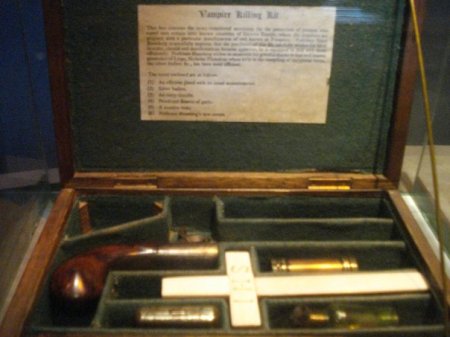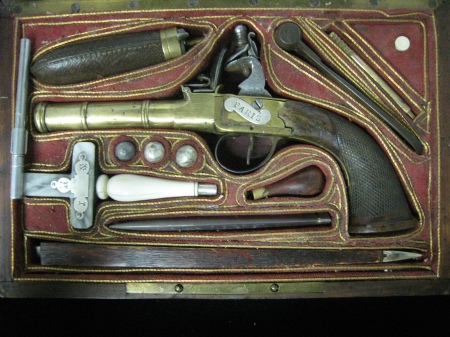I was inspired to write my own thoughts on this subject by afascinating article <these first 3 links now sadly defunct, see update below> by a “Miss Whiplash” of the excellent sceptical siteMondoSkepto. This highlights a current (shortly to finish) Ebay auction of a supposedly genuine “Vampire Killing Kit”. These have begun to emerge in recent years as a dubious type of pseudohistorical artefact, as Miss W. succintly outlines in another post on the same blog. I don’t think it’s spoiling either her articles, or my post below, to say that they are without doubt or exception, total and utter bollocks. There’s little I can say that she hasn’t already said, but I offer my musings in the hope that they are of interest to any readers. I also provide below another nail for the proverbial coffin of the Ebay kit in question.
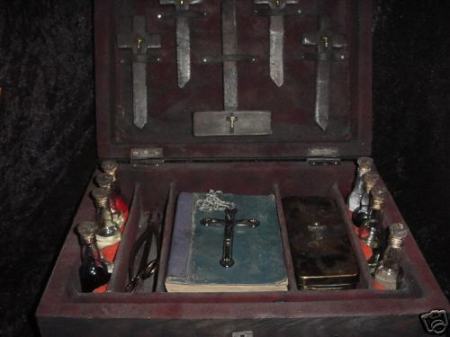
The obviously modern “vampire killing kit” now on Ebay
I have somewhat mixed feelings about the sale of these things. Clearly believers and even cynics of the paranormal might potentially fall for these obvious fakes, if they have only limited knowledge of history and experience of handling antiques and historic objects. But it’s just such a silly idea and the current Ebay piece such a bad effort, that I find it hard to raise much sympathy for any prospective buyer. That anyone might be taken in enough to drop over $1000 on it makes me sad. So, in case it isn’t immediately obvious, let’s take a look at the latest “kit”. The first thing, as Miss Whiplash points out, is that the little bottles are simply modern miniature spirits bottles with external screw-tops that give the kit a terminus post quem date of AD 1852, which of course is already later than the date offered in the auction. Screw-tops of this style were also not common until at least the 1920s. It’s not just the bottles though. For me, the overall look of the box and the implements is just… wrong. C19th artefacts and containers were hand-made, but don’t typically look as obviously rough and ready as this. The colours smack of modern acrylic paints, whilst the “stakes” look for all the world like resin or some other modelling /prop-building medium. The mallet, whilst apparently wooden, looks like no period tool I have ever seen, though obviously it could be a custom-made anomaly. As someone that regularly handles C18th-C20th books, I would place the book at the early C20th at the very latest, by style of binding and apparent wear/deterioration. Even the crisp-looking butt-hinges and hasp (which appears to be shiny stamped steel or aluminium rather than period copper alloy) are almost certainly mass-produced modern hardware store purchases. All of this is little more than educated speculation of course, but MondoSkepto’s screw-cap bottles are pretty damning, as, I would suggest is the dagger, which is a badly-aged version of this modern replica;
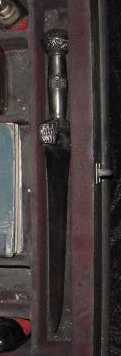
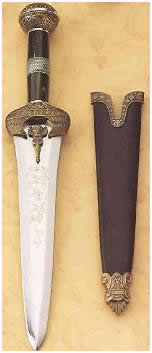
Spot the difference!
More than anything else, and what makes this even more a case ofcaveat emptor than the usual fake Ebay dross that can snare the unwary, is that it’s not even a fake of any authenticated type of artefact. In the folk tales of vampires, dedicated vampire hunters are conspicuous by their absence and (though I stand to be corrected Miss Whiplash!) there’s no suggestion that any dedicated equipment was even thought necessary. In cases we’d recognise as close to the modern conception of a vampire slaying, it’s nearly always the easily improvised wooden stake that’s the main tool, followed by decapitation/garlic in the mouth/incineration/whatever else. Silver bullets, as the other blog points out, are a latter-day Hollywood addition to the mythos, and were originally associated with werewolves (though silver in general was thought by some to counter anything supernatural).
For me all of this puts beyond help anyone choosing to bid on this stuff. Falling for a suitably aged modern replica of a well-documented type of antique is one thing, and requires only a lack of experience in the field. The level of belief required to splash $1000 on an unprecedented and anachronistic object pertaining to a supernatural creature that exists only in folklore and fiction, is something else. Interestingly, the Ebay kits are nothing terribly new. Six similar (if far more convincing-looking) kits have been sold by well-known international auction house Sotheby’s (alone) since 1994, including one in 2003 that sold for an astonishing $12,000. This is discussed at the urban legends section of About.com. The latest example, sold this April for $7,200, I have pictured below.
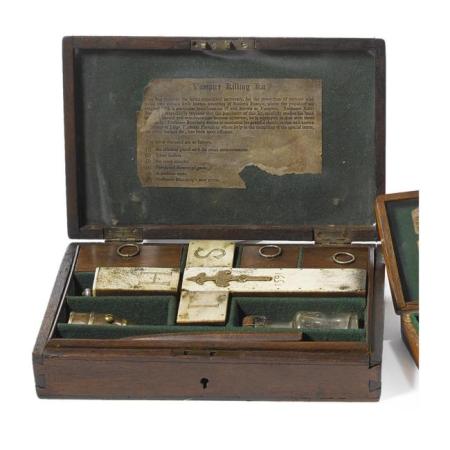
A “genuinely fake” vampire killing kit?
As well as the amusingly dinky stake, perhaps for killing mini vampires, notice the corked bottle, dovetailed hardwood box, genuine ivory, period fittings, etc etc. These are either much better fakes made using actual period components, or they are a genuine if rare type of antique. Sotheby’s, as you might expect, opt for the latter, albeit couched in quite careful language. They offer, without evidence, the theory that they were conceived of in the post-Dracula craze of the early C20th and possibly marketed to travellers to Eastern Europe (hence their small size). The line between fiction, folklore, and reality was certainly being blurred for some at that time, with Spiritualism and New Age religion on the emergence. Another possibility is that they were sold and bought as novelty items, in full knowledge (or suspicion) that there was no tradition of their use and certainly no real vampires to try them out on. The difference in quality and apparent antiquity between the Sotheby’s kits and the Ebay versions are quite clear; if the current crop are outright fakes, are the legitimately sold kits really “period fakes” in turn? The problem is that with no historical reference, they could quite easily still be modern fakes – the only pitfall for any forger would be failing to make a convincingly aged label.
This gentleman would have us believe that he started the whole thing as a bit of fun back in the 1970s, and that others have organically copied him in turn and expanded the idea. Though he claims to have drafted the label common to perhaps all of these kits, referring to the fictional Professor Ernst Blomberg and the (generically-named) “Liege gunmaker” Nicholas Plomdeur, he denies having gone so far as to produce the book by Prof Blomberg referred to in the label. This seems to be an embellishment, and one which is demonstrably fake. This pamphlet is that supplied with at least one kit, but unfortunately the content is identical to an 1891 article in The Theosophist journal by an H.S. Olcott and therefore bogus. The good professor even seems to have inspired a fictional counterpart! If Mr De Winter’s really did make the prototype kit, perhaps these latest “budget” attempts on Ebay are nothing more than a continuation of this tradition; the sort of deadpan spoof to be found on the Federal Zombie and Vampire Agency website. However, in closing I’d like to point the reader to this this vampire-related site featuring none other than one of the Ebay slayer’s kits. Perhaps they are in on the joke. I hope so. The alternatives would be too depressing to contemplate.
